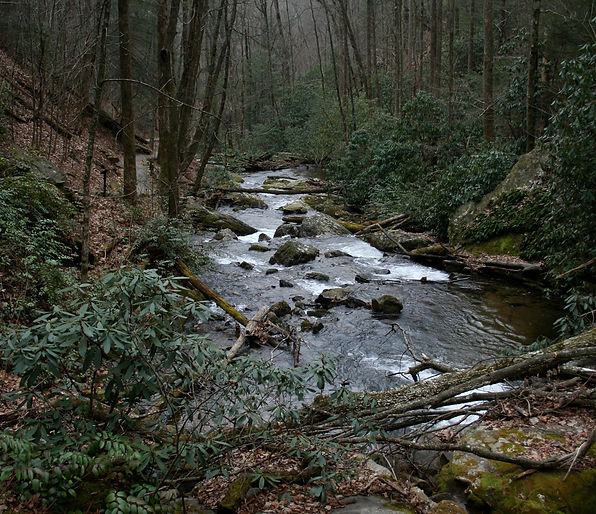
Appalachian
Treasure Hunt
Journaling Native Plants of Northeast Georgia
J. Whalen

January 1
Janus, the Greek God of the New Year, had two faces. One faced forward and one faced backward.
January 1 is a great day to get outside and take a "First Day" walk. Aside from burning off holiday calories, there's lots to see. Tree buds, wrapped tightly in moisture-conserving bud-scales, are all very distinctive and useful in identifying trees. Tree profiles, completely covered by leaves in the other three seasons, are open for our admiration and study. The "vistas" are breath-taking in the mountains and along the lakes. Take your family and your dogs out to enjoy the winter!
"I prefer winter and fall, when you feel the bone structure of the landscape...the loneliness of it, the dead feeling of winter. Something waits beneath it, the whole story doesn't show." Andrew Wyeth

January 2
Hazel Alders can be found along lake and creek banks all over Northeast Georgia. They bloom in January! At the top are the female flowers. The long catkins at the bottom are male. If you tap the male catkins with your fingers, some time in the next few weeks, the pollen will puff out. Alders are wind pollinated so the pollen lands on the female flowers and by fall they turn into cones with tiny seeds to drop and grow into new alder trees. (Alnus serrulata, Betulaceae) Unicoi Lake

January 3
A walk in the woods, or in your neigborhood, is a good time to look at the winter tree buds. The buds of each species are all very different. The one above is a buckeye bud. Note the "fuzz" on the stem. (Aesculus spp, Hippocastinaceae) Hall County

January 4
Seedling in Winter Moss

January 5
The berries above are partridge berries (Mitchella repens, Rubiaceae). In the spring their tiny white flowers grow in pairs. By fall the flower "ovaries" have fused and one berry results...with two small marks where the flowers were. This plant makes a beautiful low ground cover under mountain trees. (Raven Cliff Falls)

JANUARY 6
This is one of several native wild gingers in Northeast Georgia. The roots were used by Native Americans for cooking. Their spring flowers are found under the leaves in April. (Unicoi Lake)

January 7
These tiny green leaves, mixed in with fallen brown leaves, are easy to miss. Check the underside and you'll see an intense purple color. You will have found a member of the very large orchid family: Crane Fly Orchid (Tipularia discolor, Orchidaceae). Unicoi Lake (Look in June for the flower spikes)

January 8
This is not an alien spaceship, as you might think. It's a Rosebay Rhododendron bud (Rhododendron maximum, Ericaceae). Its bud scales are tightly closed, and will open toward the end of June with bright pink flower buds, then pale pink flowers. Unicoi Lake



A snow in the night, and an early morning walk to see who has been visiting.
January 9

January 10
Tree Lungwort, along Richard Russell Parkway
(Lobaria pulmonaria, Lobariacea)

Our beautiful evergreen hemlock trees are stressed, and many are dying, because of an invasion of the hemlock woolly adelgid (Adelges tsugae). Be a part of the research to find a way to protect them.
January 11

Hemlocks have our tiniest cones

Hemlock with
woolly adelgids
(Tsuga canadensis, Pinaceae)
January 12

If you are walking in January and see green ferns, you're probably looking at Christmas ferns (Polystichum acostichoides, Dryopteridaceae). They are our only native evergreen fern.

January 13
Your well behaved dog-on-a-leash is always welcome to walk with you along our many beautiful hiking trails of Northeast Georgia.

January 14
Rosettes of Michaux's Saxifrage (Micranthes petiolaris, Saxifragaceae) can be found on wet rocky surfaces along trails in January. In spring, stalks shoot up with tiny white flowers. (Duke's Creek Falls Trail)



A foggy day in the winter is a good day to study the very distinct profiles of each different tree species.
(Richard Russell Parkway)
January 15

White Pine, Ice Storm
January 16

January 17
Sweet Gum "winged" branches.
(Liquidamber styraciflua, Hamamelidaceae)

January 18
Often bright green moss is the only color to be seen in the brown and gray landscape of January.

January 19
The bark of Beech trees is smooth and gray. The papery brown leaves hang on until the new leaves appear in March! (Fagus grandiflora, Fagaceae)

January 20
It's too cold today to go anywhere!


January 21
Shelf fungi in snow. Who would expect to see pink in January?

January 22
Classic shape for our native mountain laurels. (Kalmia latifolia, Ericaceae) Lake Winfield Scott

January 23
Winter Creek with Evergreens, Anna Ruby Falls

January 24

Along the Appalachian Trail

January 25
Hazel Alders along Unicoi Lake
Alnus serrulata, Betulaceae

January 26
Wilderness Art

New from Old
January 27

January 28
You never know who you'll see in the woods!

January 29
January Still Life With Beech Leaf

January 30
Galax (Galax rotundifolia, Diapensiaceae), with it's shiny and reddish tinted leaves, is a bright spot on a winter walk. In June, spikey white flower clusters will shoot up.

January 31
An almost frozen Lake Winfield Scott.
Some of the "old-timers" remember skating there.
"A cardinal
on a gray branch bounces
in the wind...
two fluffy ounces!"
JW